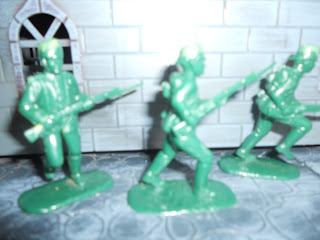Toyway Egyptians And What Colour Should They Be?
I like the Toyway ancients, my favourites being their Greeks, followed by their Romans. The Egyptians are my third choice,mostly because the poses are static. All these figures come pre-painted in a hard wearing vinyl paint. This saves time if you want an army quickly and don't want to paint it. I decided, for the time being at least, just to base the figures so they are ready if I need them for a game. So far I have used some in a game where they pretended to be Aztecs and some of the ones in quilted tunics lend themselves to this.
The paint schemes,whilst colourful are questionable. Their clothes are too colourful; the basic colour for Egyptian clothing was white, with coloured trim for notables. Also the skin colour is also questionable, although arguably the very dark skin colour could suggest that they are Nubians.
I have always depicted the bulk of my ancient Egyptians in a coppery brown colour, reflecting the bulk of their artistic depictions. These latter most commonly show people, other than Nubians, in a reddish brown skin colour. Also shown are very pale and very dark skin colours, although the latter is usually in connection with Nubians who also have Negroid features. To further complicate things, Egyptian art was not always true to life and was making symbolic statements.
I decided to do some research on this lately and found that this is a very political topic. White supremacist sites contend that the Egyptians were ruled by white people and, at the other extreme, Afrocentric sites contend that they were'black' along with Sumerians and even the odd Viking)! The Afrocentric writers refer to traditional European historians as 'albino historians'!
The most common historical view is that the ancient Egyptians were mostly Caucasian (which is not the American police profile definition of being white) with some Negroid mixture. The current population of Egyptians,whilst not identical to ancient Egyptians, is one source, DNA testing of mummies and other tests as well as Egyptian art and ancient accounts are others. Herodotus referred to ancient Egyptians as 'black' although this may have just been a relative contrast to his own people. When Australia opened up to significant numbers of non-British immigration in the 1950s the Southern Europeans were regarded as extremely dark by the Anglo-Irish population.
Interestingly, the Ramses the Second mummy had its hair tested and it was found to be red. I doubt if that meant a bright red Celtic type and probably meant red-brown but I am guessing on this - maybe he was a bright red type. This color was not related to the mummification process. The funeral mask showed Ramses as having blue eyes and this depiction has also been found in other Egyptian depictions as well as Sumerian. I'm not sure what this says about the family origins of some pharaohs. This does not apply to all pharaohs and we are talking about thousands of years and a number of dynasties but red hair was shared by his ancestors and others. In fact his DNA mostly associated with the DNA of Northern Europeans so maybe he was related to the Celts! Paint a pharaoh figure with red hair and light skin and you can shock the critic who says this is inaccurate when you relate a historical basis for this! I wouldn't be making the rank and file soldiers this color though.
The additional complication is the Greek take over of Greece from Alexander the Great's conquest, leaving the Ptolemaic dynasty. One could definitely assume a lighter skinned ruling group in that time. However it has been claimed that the tomb of Cleopatra's sister has been found and that she may have had some North African lineage.
Having said all that I settle for my original idea which is a mid-brown or coppery skin color for most of my Egyptians. At least some of the dynasties had lighter skinned rulers but even then I would not be going necessarily for lily white Scandinavian types.
As my figures will mostly be used in a fictional world, in the last resort it doesn't matter what color their clothes and skin are but i do start from a historical basis I can use my ancient Egyptians as ancient Egyptians if I so choose.Eventually I'll re-paint at least some of these figures.
Below are the two packets based on card and given sand bases.
The paint schemes,whilst colourful are questionable. Their clothes are too colourful; the basic colour for Egyptian clothing was white, with coloured trim for notables. Also the skin colour is also questionable, although arguably the very dark skin colour could suggest that they are Nubians.
I have always depicted the bulk of my ancient Egyptians in a coppery brown colour, reflecting the bulk of their artistic depictions. These latter most commonly show people, other than Nubians, in a reddish brown skin colour. Also shown are very pale and very dark skin colours, although the latter is usually in connection with Nubians who also have Negroid features. To further complicate things, Egyptian art was not always true to life and was making symbolic statements.
I decided to do some research on this lately and found that this is a very political topic. White supremacist sites contend that the Egyptians were ruled by white people and, at the other extreme, Afrocentric sites contend that they were'black' along with Sumerians and even the odd Viking)! The Afrocentric writers refer to traditional European historians as 'albino historians'!
The most common historical view is that the ancient Egyptians were mostly Caucasian (which is not the American police profile definition of being white) with some Negroid mixture. The current population of Egyptians,whilst not identical to ancient Egyptians, is one source, DNA testing of mummies and other tests as well as Egyptian art and ancient accounts are others. Herodotus referred to ancient Egyptians as 'black' although this may have just been a relative contrast to his own people. When Australia opened up to significant numbers of non-British immigration in the 1950s the Southern Europeans were regarded as extremely dark by the Anglo-Irish population.
Interestingly, the Ramses the Second mummy had its hair tested and it was found to be red. I doubt if that meant a bright red Celtic type and probably meant red-brown but I am guessing on this - maybe he was a bright red type. This color was not related to the mummification process. The funeral mask showed Ramses as having blue eyes and this depiction has also been found in other Egyptian depictions as well as Sumerian. I'm not sure what this says about the family origins of some pharaohs. This does not apply to all pharaohs and we are talking about thousands of years and a number of dynasties but red hair was shared by his ancestors and others. In fact his DNA mostly associated with the DNA of Northern Europeans so maybe he was related to the Celts! Paint a pharaoh figure with red hair and light skin and you can shock the critic who says this is inaccurate when you relate a historical basis for this! I wouldn't be making the rank and file soldiers this color though.
The additional complication is the Greek take over of Greece from Alexander the Great's conquest, leaving the Ptolemaic dynasty. One could definitely assume a lighter skinned ruling group in that time. However it has been claimed that the tomb of Cleopatra's sister has been found and that she may have had some North African lineage.
Having said all that I settle for my original idea which is a mid-brown or coppery skin color for most of my Egyptians. At least some of the dynasties had lighter skinned rulers but even then I would not be going necessarily for lily white Scandinavian types.
As my figures will mostly be used in a fictional world, in the last resort it doesn't matter what color their clothes and skin are but i do start from a historical basis I can use my ancient Egyptians as ancient Egyptians if I so choose.Eventually I'll re-paint at least some of these figures.
Below are the two packets based on card and given sand bases.













James, I had the same questions when I was painting Tony's Egyptians. We ended up having dark colored ones to represent Nubians, Then brown colored ones and some light colored ones to represent the other races that may have inhabited Egypt at the time. Our discussions revolved around the fact that Egypt was a melting pot for centuries and thus will most likely have every race under the sun in the region at the time. Also even if they do end up having mostly caucasians, caucasians can be very dark skinned like Arabs and Indians to light colored like Vikings and Brits. So I guess whatever skin color you choose would not be deemed wrong. :D
ReplyDelete